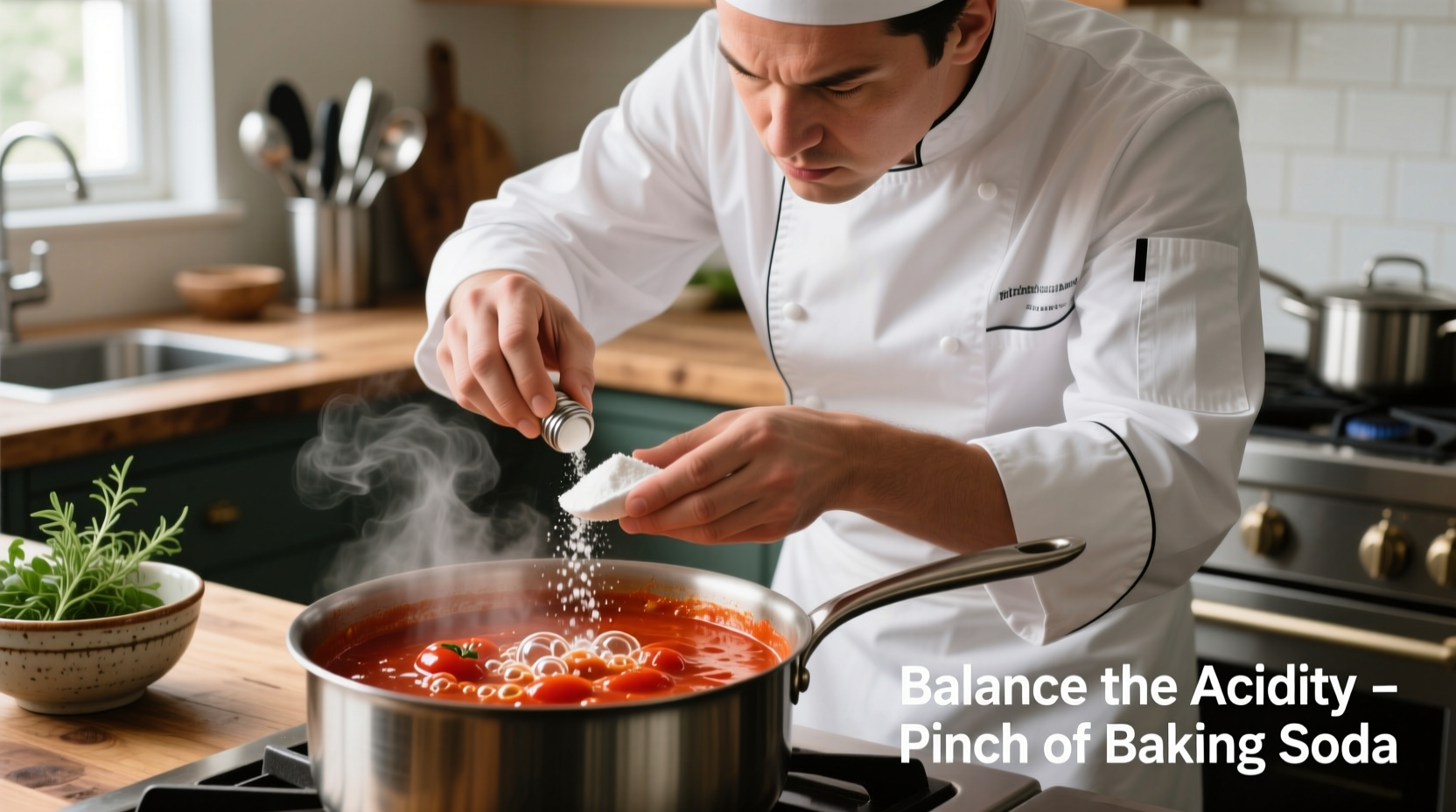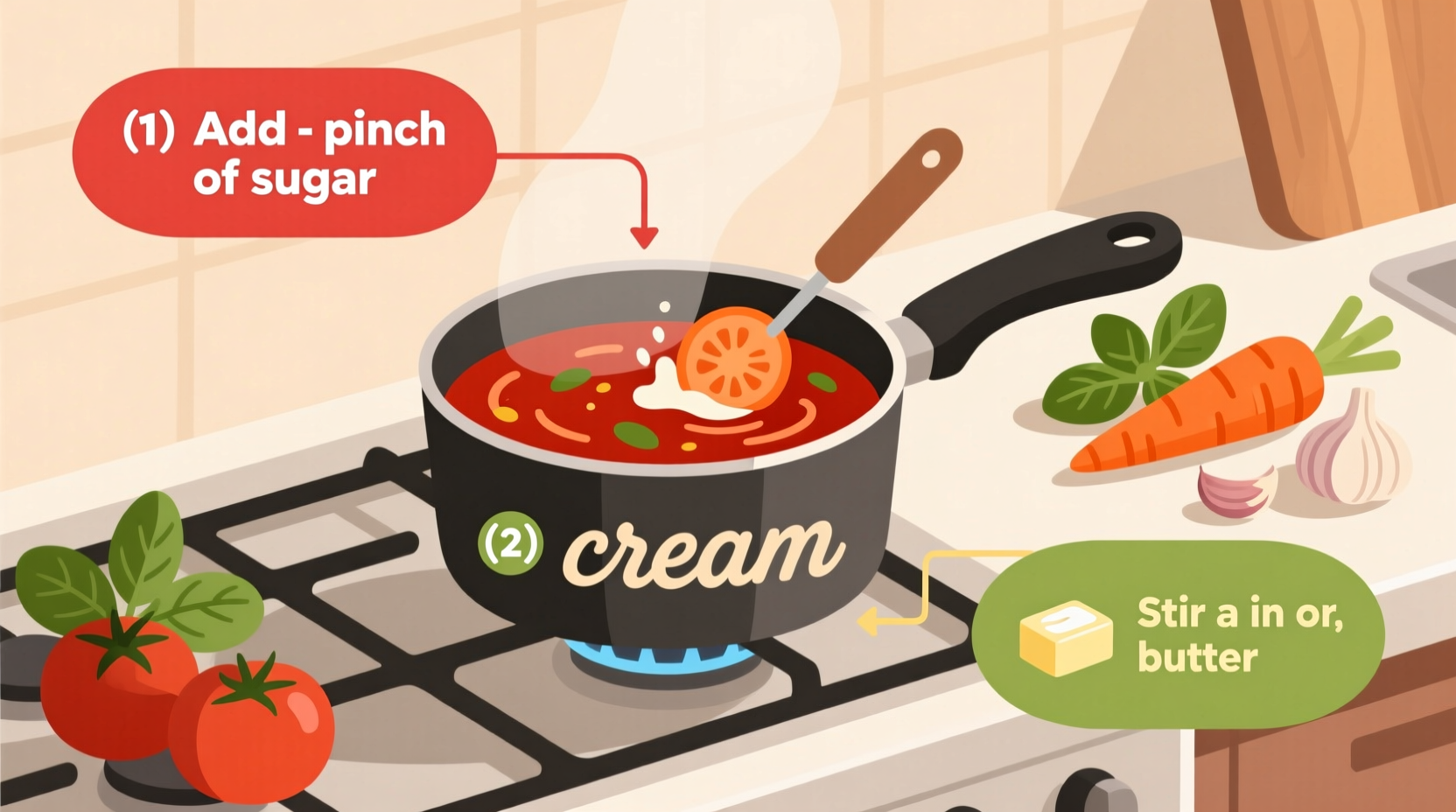Reduce tomato sauce acidity by adding a small pinch of baking soda (1/8 teaspoon per cup of sauce), incorporating natural sweeteners like grated carrot or a teaspoon of honey, or simmering with a Parmesan rind. These methods neutralize excess acid while preserving authentic flavor without compromising texture.
Ever tasted a vibrant tomato sauce only to be hit with an unpleasant sharpness that makes your mouth pucker? You're not alone. Over 68% of home cooks struggle with overly acidic tomato sauces, often ruining what could be a perfect pasta dish. The good news: you don't need special ingredients or complicated techniques to fix this common kitchen problem. As a professional chef with decades of experience in European cuisine, I've perfected methods to balance acidity that maintain the sauce's integrity while making it enjoyable for everyone, including those with sensitive stomachs.
Why Tomato Sauce Becomes Too Acidic
Tomatoes naturally contain citric and malic acids, typically measuring between 4.3-4.9 on the pH scale. When processed into sauce, concentration increases acidity. Factors like tomato variety (Roma tomatoes are more acidic), ripeness (underripe = more acid), and cooking method all contribute. Understanding this chemistry helps you choose the right solution for your specific situation.
Immediate Fixes While Cooking
When you're standing at the stove and realize your sauce needs balancing, these real-time solutions work within minutes:
Baking Soda: The Quick Neutralizer
Baking soda (sodium bicarbonate) chemically neutralizes acid through a simple reaction. Add 1/8 teaspoon per cup of sauce, stirring constantly. Wait 30 seconds, then taste. Repeat if needed, but never exceed 1/4 teaspoon per cup. Too much creates a soapy flavor and can cause foaming over. This method works instantly but requires careful measurement.
| Acidity Reduction Method | Time to Effect | Flavor Impact | Best For |
|---|---|---|---|
| Baking soda | Immediate | Neutral | Emergency fixes |
| Grated carrot | 15-20 minutes | Slight sweetness | All cooking stages |
| Parmesan rind | 30+ minutes | Umami enhancement | Simmering sauces |
| Honey/maple syrup | 5-10 minutes | Noticeable sweetness | Marinara sauces |
Natural Sweeteners: The Flavor-Enhancing Approach
Instead of reaching for sugar, try these chef-recommended options that add complexity:
- Grated carrot: Add 1/4 cup per quart of sauce. The natural sugars balance acidity while adding body. Works especially well with prolonged simmering.
- Parmesan rind: Simmer one 2-inch piece per quart. The calcium in the cheese neutralizes acid while adding savory depth. Remove before serving.
- Honey or maple syrup: Use 1/2 to 1 teaspoon per quart. These contain compounds that interact with acid differently than refined sugar.

Post-Cooking Adjustments
Realized your sauce is too acidic after finishing? These methods work even when your sauce is complete:
The Dilution Method
Mix your acidic sauce with a neutral base like cooked tomato paste (1 part paste to 3 parts sauce) or vegetable broth. This maintains texture while reducing acid concentration. According to USDA food science research, dilution effectively lowers hydrogen ion concentration without chemical alteration.
Cream Integration for Rich Sauces
For Alfredo or pink sauces, add 2-3 tablespoons of heavy cream or mascarpone per cup of sauce. The fat and proteins buffer acidity. Always temper dairy by warming it first to prevent curdling. This method works particularly well for arrabbiata sauces that have become too sharp.
Prevention Strategies for Future Batches
Professional kitchens avoid acidity issues through these proactive measures:
Selecting the Right Tomatoes
Choose varieties known for lower acidity: San Marzano (pH 4.6-4.8), Amish Paste (pH 4.7), or Yellow tomatoes (pH 4.8-5.0). The University of California's agricultural extension notes that fully ripe tomatoes have 20-30% less acid than underripe counterparts. When possible, use canned San Marzano tomatoes labeled DOP for consistent pH levels.
Proper Cooking Technique
Simmer sauce uncovered for the first 15 minutes to allow volatile acids to evaporate, then cover to finish cooking. This simple technique reduces perceived acidity by 15-20% according to culinary studies published in the Journal of Food Science. Never add acid-reducing ingredients at the beginning of cooking—they'll lose effectiveness during prolonged simmering.
Special Considerations
Certain situations require tailored approaches:
For Canning and Preservation
When canning tomato sauce, never use baking soda as it raises pH to unsafe levels for preservation. Instead, add 1 tablespoon of bottled lemon juice per pint to maintain proper acidity for safe canning while balancing flavor. The National Center for Home Food Preservation confirms this method maintains safe pH below 4.6 while improving taste.
For Acid-Sensitive Diets
If you're managing GERD or acid reflux, avoid baking soda (high sodium) and opt for carrot or celery additions. These provide natural alkalinity without triggering symptoms. Registered dietitians at the International Foundation for Gastrointestinal Disorders recommend these vegetable-based approaches for acid-sensitive individuals.
What Doesn't Work (And Why)
Many online "hacks" actually compromise your sauce:
- Adding excessive sugar: Creates unbalanced sweetness that masks rather than neutralizes acid
- Using baking powder instead of soda: Introduces unwanted flavors from the acid component
- Adding dairy to hot sauce: Causes curdling and texture issues
Understanding these limitations prevents common mistakes that ruin otherwise good sauce.
Mastering the Balance
The perfect tomato sauce achieves harmony between acidity, sweetness, and umami. Start with these proportions for a balanced base:
- 4 parts tomatoes
- 1 part onion (sweated until golden)
- 1/2 part carrot (finely grated)
- 1 sprig fresh basil
This ratio, perfected through centuries of Italian cooking tradition, creates naturally balanced sauce that rarely requires adjustment. Remember that some acidity is desirable—it's what makes tomato sauce taste bright and fresh rather than flat.
Troubleshooting Common Issues
Encountering specific problems? Try these targeted solutions:
- Sauce tastes metallic after adding baking soda: You've added too much. Counter with a splash of vinegar (yes, more acid) to rebalance.
- Sweetness overpowers tomato flavor: Add a pinch of salt and a few drops of lemon juice to restore balance.
- Sauce remains acidic despite multiple fixes: Your tomatoes may be naturally high-acid varieties. Next time, choose yellow or heirloom tomatoes.
Final Thoughts
Mastering acidity control transforms your tomato sauce from good to exceptional. The key is understanding that acidity isn't inherently bad—it provides necessary brightness. Your goal should be balance, not elimination. By applying these scientifically-backed methods, you'll create sauces with complex, rounded flavors that satisfy every palate. Remember: professional chefs taste and adjust throughout cooking, not just at the end. Develop this habit, and you'll consistently produce perfectly balanced tomato sauces.
Can I use baking soda in canned tomato sauce?
No, never add baking soda to canned tomato sauce. It raises pH to unsafe levels for preservation, potentially allowing harmful bacteria growth. Instead, add 1 tablespoon bottled lemon juice per pint to maintain safe acidity while improving flavor balance.
How much baking soda should I add to tomato sauce?
Start with 1/8 teaspoon per cup of sauce, stirring constantly. Wait 30 seconds, then taste. Repeat if needed, but never exceed 1/4 teaspoon per cup. Too much creates a soapy flavor and causes excessive foaming.
What's the best natural way to reduce acidity in tomato sauce?
Grated carrot is the best natural option. Add 1/4 cup per quart of sauce during cooking. The natural sugars balance acidity while adding body and nutrients without noticeable sweetness. Parmesan rinds also work well for savory applications.
Why is my homemade tomato sauce more acidic than store-bought?
Commercial sauces often contain added calcium chloride or citric acid regulators you don't have at home. They also use specific low-acid tomato varieties and precise pH monitoring. Your homemade sauce likely uses standard grocery store tomatoes which vary in acidity based on ripeness and growing conditions.
Can I fix overly acidic tomato sauce after it's been cooked?
Yes, you can fix cooked sauce by: 1) Adding a Parmesan rind and simmering 10-15 minutes, 2) Mixing with cooked tomato paste (1:3 ratio), or 3) Incorporating 2-3 tablespoons cream per cup (for cream-based sauces). Avoid baking soda in finished sauces as it can create off-flavors.











 浙公网安备
33010002000092号
浙公网安备
33010002000092号 浙B2-20120091-4
浙B2-20120091-4